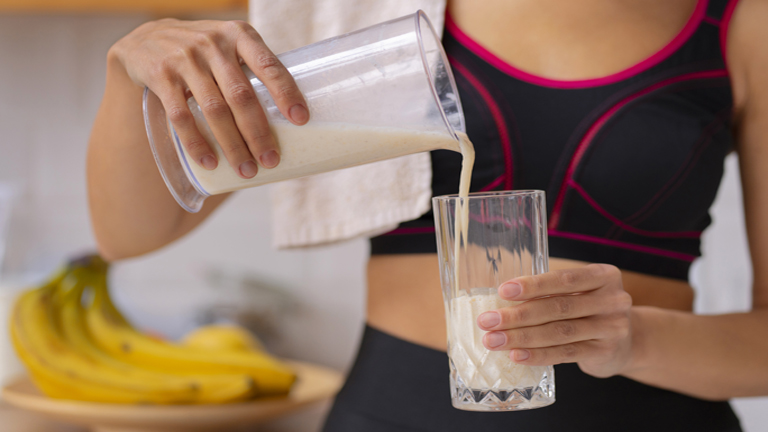Protein shakes have become a staple in the fitness and health industry, offering a convenient way to meet daily protein requirements. Whether you’re an athlete, bodybuilder, or someone looking to improve overall health, protein shakes can be a game-changer.
In this comprehensive guide, we’ll explore everything you need to know about protein shakes—types, benefits, potential side effects, and delicious recipes. By the end, you’ll have a clear understanding of how to incorporate protein shake into your diet effectively.
Must Check: Best Morning Detox Water
What Are Protein Shakes?
Protein shake are beverages made by mixing protein powder with water, milk, or other liquids. They provide a quick and efficient way to increase protein intake, which is essential for muscle repair, recovery, and overall body function.
Why Are Protein Shakes Popular?
-
Convenience: Quick to prepare, ideal for busy lifestyles.
-
Muscle Growth: Supports muscle protein synthesis.
-
Weight Management: Helps in appetite control and fat loss.
-
Recovery: Aids in post-workout muscle repair.
Types of Protein Powders
Not all protein powders are the same. Here are the most common types:
1. Whey Protein
-
Fast-digesting, ideal post-workout.
-
Contains all essential amino acids.
-
Types: Concentrate, Isolate, Hydrolysate.
2. Casein Protein
-
Slow-digesting, best before bedtime.
-
Helps prevent muscle breakdown overnight.
3. Plant-Based Protein (Pea, Soy, Hemp, Rice)
-
Great for vegans and lactose-intolerant individuals.
-
May require combining sources for complete amino acid profile.
4. Egg White Protein
-
High-quality, dairy-free option.
-
Rich in leucine, crucial for muscle growth.
5. Collagen Protein
-
Supports skin, hair, and joint health.
-
Not a complete protein but beneficial for recovery.
Benefits of Protein Shakes
1. Supports Muscle Growth and Repair
Protein is made of amino acids, the building blocks of muscle. Consuming protein shake after workouts helps repair muscle fibers and promote growth.
2. Aids in Weight Loss
High-protein diets increase satiety, reducing overall calorie intake. Studies show protein helps maintain lean muscle while losing fat.
3. Enhances Recovery
Post-exercise protein intake reduces muscle soreness and speeds up recovery.
4. Convenient Nutrition
For those with busy schedules, protein shake offer a quick and portable meal replacement.
5. Boosts Metabolism
Protein has a high thermic effect, meaning the body burns more calories digesting it compared to fats and carbs.
How to Choose the Best Protein Shake
1. Identify Your Goal
-
Muscle Gain? Opt for whey or casein.
-
Weight Loss? Choose low-carb, high-protein options.
-
Vegan? Go for plant-based proteins like pea or soy.
2. Check Ingredients
Avoid shakes with excessive sugar, artificial sweeteners, or fillers.
3. Consider Digestibility
Lactose-intolerant individuals should avoid whey concentrate and opt for isolates or plant-based proteins.
4. Protein Content per Serving
Aim for 20-30 grams of protein per shake for optimal muscle synthesis.
When to Drink Protein Shakes
1. Post-Workout (Within 30 Minutes)
Fast-absorbing whey protein helps kickstart muscle recovery.
2. As a Meal Replacement
Great for breakfast or a quick lunch when whole foods aren’t available.
3. Before Bed (Casein Protein)
Slow-digesting casein provides a steady release of amino acids overnight.
4. Between Meals
Helps curb cravings and keeps protein intake consistent.
Potential Side Effects of Protein Shakes
While protein shake are generally safe, excessive intake may cause:
-
Digestive issues (bloating, gas).
-
Kidney strain in individuals with pre-existing conditions.
-
Weight gain if consumed in excess without exercise.
Tip: Stick to recommended doses (1-2 shakes per day) and consult a doctor if you have kidney issues.
Delicious Protein Shake Recipes
1. Classic Chocolate Whey Shake
-
1 scoop chocolate whey protein
-
1 cup almond milk
-
1 banana
-
1 tbsp peanut butter
-
Ice cubes
Blend until smooth!
2. Vegan Berry Protein Smoothie Protein Shakes
-
1 scoop plant-based vanilla protein
-
1 cup coconut milk
-
½ cup mixed berries
-
1 tbsp chia seeds
Blend and enjoy!
3. Coffee Protein Shake (Pre-Workout Boost) Protein Shakes
-
1 scoop vanilla whey
-
1 cup cold brew coffee
-
½ cup Greek yogurt
-
Ice cubes
Perfect for an energy kick!
Frequently Asked Questions (FAQs) Protein Shakes
1. Are Protein Shakes Safe for Everyone? Protein Shakes
Yes, unless you have kidney disease or allergies to specific protein sources.
2. Can I Replace Meals with Protein Shakes? Protein Shakes
Occasionally, yes—but whole foods should be the primary nutrition source.
3. How Much Protein Do I Need Daily? Protein Shakes
-
Sedentary adults: 0.8g per kg of body weight.
-
Athletes: 1.2-2.2g per kg.
4. Do Protein Shakes Cause Weight Gain? Protein Shakes
Only if consumed in excess without balancing calories.
Conclusion
Protein shakes are a versatile and effective way to boost protein intake, whether for muscle growth, weight loss, or general health. By choosing the right type, timing, and recipes, you can maximize their benefits.
Ready to upgrade your nutrition? Try these protein shake recipes today and experience the difference!
Final Tips for Best Results:
✔ Stay hydrated to help protein digestion.
✔ Combine with whole foods for balanced nutrition.
✔ Monitor your body’s response and adjust as needed.
By following this guide, you’ll be well on your way to optimizing your protein intake and achieving your fitness goals!
Did you find this guide helpful? Share it with your friends and start your protein shake journey together!


